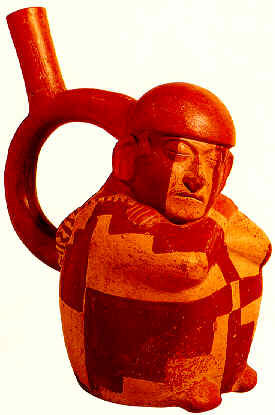Geplaatst op vrijdag 10 januari 2003 @ 22:04 , 2087 keer bekeken
 Overview of the Moche Civilization...
Overview of the Moche Civilization...
The Moche (aka the Mochica, Early Chimu, Pre-Chimu, Proto-Chimu, etc...) were a pre-Columbian culture on the Northern coast of Peru. (The common appellation of "northwest" is somewhat redundant, since Peru does not have any coastline on its Eastern border.) That area is mostly dry desert lands, watered sporadically by heavy el nino rains. Luckily for the inhabitants of the region, oasis valleys have developed along numerous small rivers which come down from the Andes to the coast, and it is in such valleys that the Moche culture flourished.
Inspired largely by a local legend about a heroic figure called "Naymlap," some think that the Moche came from outside of Latin America and landed in balsa rafts around the Lambeyeque valley. Generally accepted theory, though, says that early Moche settlement was in three valleys: the Chicama, the Moche, and the Viru, with the population most concentrated in the Moche valley.
The most generous dates given for the Moche cover a broad span of time, as early as c. 300 B.C. and as late as c. A.D. 1000. Stricter views typically have the Moche spanning c. A.D. 200 to c. 700. It is certainly during this time that the the Moche reached their height of cultural dominance.
It is important to remember, though, that people do not pop up in a vacuum: the "Moche" did not spontaneously appear in the year 200 or spontaneously vanish in the year 700. Rather, the Moche culture probably "grew out of" other peoples and cultures, and probably dissipated over a period of time as well. From which cultures the Moche developed and to where the Moche went is
What happened between 100 and 700 is a bit murky as well, but it is clear that the Moche grew to be influential throughout much of the Northern coast, as suggested by the dominance of the Moche artistic style. This "conquest" of Peru may have been military, as could be suggested by the martial themes in much Moche iconography, but it is more likely to have been the result of a much more subtle, cultural pervasion -- what an archaeologist might call secondary diffusion.
Moche history is often divided into five developmental phases which were originally based almost solely upon pottery design. (See Donnan's Moche Art of Peru for perhaps the best illustration and explanation of the phase system. Also note that it is currently believed that the Phase chronology is only accurate for the southern vallies in the Moche's region, and that a totally separate sequence was true in the North.)
The first phase produced the simplest art, and it has traditionally been thought that the civilization of this phase was correspondingly simple and peaceful. Dr. Christopher Donnan's work is starting to change some of these conceptions, however (see Donnan's "Rethinking Moche Phase I"). The first phase would also logically be the phase during which the Moche were closest in artistic and philosophical expression to their culutral antecedents.
In the second and third phases, the art of the Moche began to develop -- pottery vessels became more complex, and rudimentary slip-painting began to become more detailed fine-line drawings. The iconographic motifs commonly associated with the Moche bgan to develop. In the fourth phase, the art became refined, the designs complicated, and the motifs well-entrenched.
By the time of the fifth and final phase, Moce art was at its most technically complex, to the point where most empty space was filled in with intricate patterns. The art also began to reflect a more war-like and more ritualistic culture. It could be argued that this reflects more the development of artistic representation than dramatic changes in the character of the culture being represented, but many people theorize that the war themes in the art reflect a growing militarism in their culture, and perhaps the onset of a military threat from abroad.
What happened to the Moche at the end of Phase V is very much uncertain. I will eventually devote a page here to the subject of how their demise actually took place, or at least discussions of that topic, but for now, it will suffice to say that the Moche were succeeded by the Huari (though see Michael Czwarno, Huari: Nature of an Empire) and later the Chimu. The Moche and the Chimu share many basic concepts and symbols, leading to the early designations of the Moche as "Early Chimu" and so forth. While this presumption of relationship is almost certainly un-fair to the Moche, and unrealistic given the two hundred or so year gap between the two cultures, the exact nature of their relationship remains an intriguing mystery.
Bron: http://members.tripod.com/~Moche/Moche_Main.html
 Overview of the Moche Civilization...
Overview of the Moche Civilization...  Overview of the Moche Civilization...
Overview of the Moche Civilization...